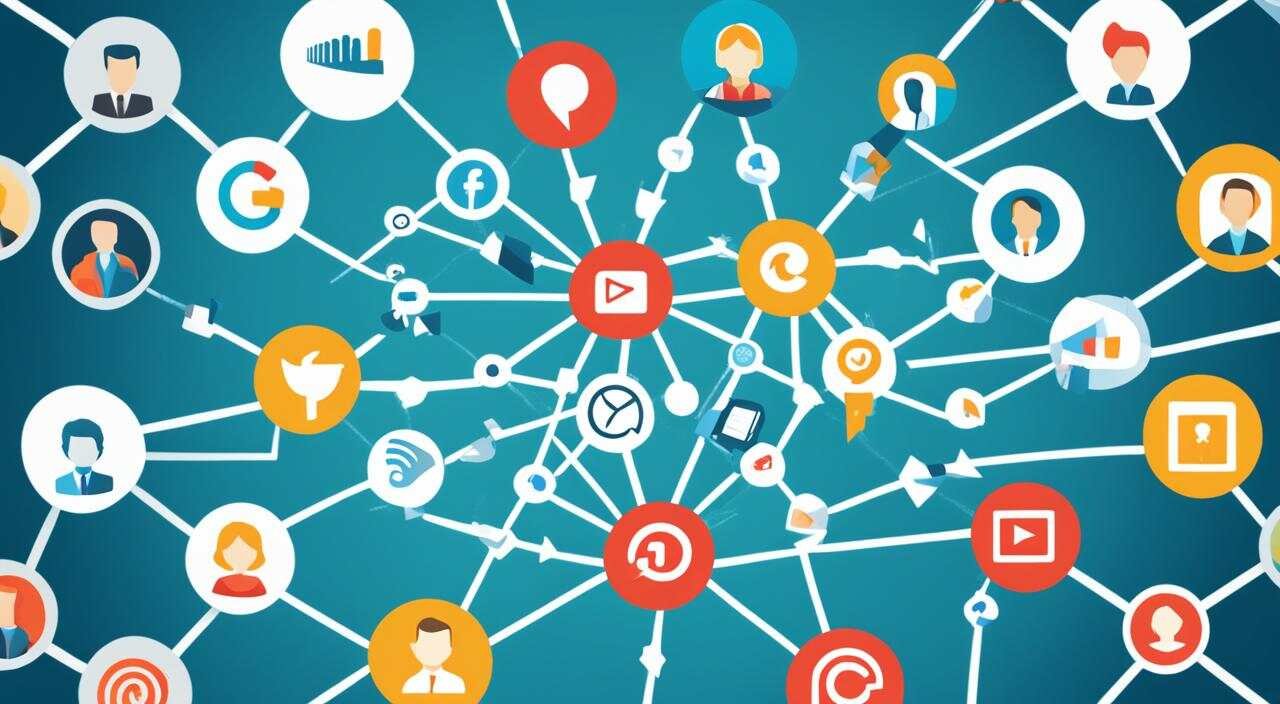Visual communication is not just a trend, it’s a necessity in today’s fast-paced and visually-driven world. Incorporating visual elements like images, graphics, and videos in your communication strategies can have a profound impact on your success. It goes beyond just making your content look attractive; visual communication enhances message clarity, engagement, and information retention.
When you integrate visual content in your communications, you save time and improve performance. Studies have shown that businesses can save up to $1,200 per year per employee by incorporating visual content. But it’s not just about cost savings. Visual communication bridges the gaps in traditional text-based communication, catering to different learning styles and engaging a diverse workforce.
Visual communication is essential for capturing the attention of your audience. It improves communication effectiveness and information retention by creating more memorable information through symbols and icons. It harnesses colors to attract attention and uses elements like text, icons, shapes, imagery, and data visualizations to create meaning for the audience.
In this article, we will explore the importance of visual communication, the benefits it offers, and how you can leverage it to achieve success in various sectors.
Key Takeaways:
- Visual communication enhances message clarity, engagement, and information retention.
- It saves time, improves performance, and can significantly impact business outcomes.
- Visual communication bridges the gaps in traditional text-based communication.
- It caters to different learning styles and engages a diverse workforce.
- Visual communication creates more memorable information through symbols, icons, and colors.
What is Visual Communication?
Visual communication encompasses two parts: communication design and graphic design.
Communication design involves crafting a message that educates, motivates, and engages the viewer. It focuses on the content and the fundamental principles of effective communication. A well-designed communication encourages understanding and elicits the desired response from the audience.
Graphic design, on the other hand, is the art of creating visually appealing and impactful designs. It utilizes various design elements and principles to communicate the message in a clear and eye-catching manner. Through the strategic use of typography, color, layout, and imagery, graphic design enhances the visual experience and helps convey the intended message effectively.
Visual communication is about selecting elements that create the most meaning for the audience. It encompasses text, icons, shapes, imagery, and data visualizations, all working together to convey messages and evoke emotions.
In the realm of visual communication, there are several common strategies and techniques that professionals use to effectively convey information. These include:
- Utilizing data visualizations to illustrate the impact of work or convey complex information in a digestible format
- Using shapes and lines to outline processes, flows, or hierarchies
- Creating memorable information through the use of symbols and icons
- Telling stories through visuals and data, allowing the audience to engage and connect with the narrative
Color also plays a significant role in visual communication. It can be used to illustrate importance, highlight key elements, create visual hierarchy, and attract attention.
Elements of Visual Communication
Visual communication relies on various elements to create meaning and captivate the audience. These elements include:
Elements of Visual Communication Description Text The written or spoken words used to convey information or messages. Typography plays a crucial role in determining the visual impact of text. Icons Visual representations that symbolize meaning or concepts. Icons are often used to enhance understanding and provide quick recognition. Shapes Geometric or organic forms used to convey meaning or represent objects. Shapes can be used to create visual hierarchy and organize information. Imagery Photographs, illustrations, or other visual representations that enhance understanding, evoke emotions, or support the message. Data Visualizations Graphs, charts, infographics, or other visual representations of data that simplify complex information and enable better comprehension.
By effectively combining these elements, visual communication professionals can create engaging and impactful designs that convey messages with clarity and evoke the desired response from the audience.
Why is Visual Communication Important?
Visual communication plays a crucial role in today’s diverse and fast-paced workplace. It is essential for overcoming information overload and increasing communication effectiveness. Traditional text-based communication can easily be overlooked or ignored amidst various distractions. By incorporating high-quality images and videos, communication becomes more engaging and impactful, capturing the attention of viewers.
One of the key benefits of visual communication is its ability to improve information retention. Visuals create long-term memories associated with the content, making it easier for individuals to recall and seek out more information. Visual communication supports reading comprehension and memory by highlighting main points and connecting them to relevant contexts in the viewer’s life.
The brain processes visual information more effectively, allowing the team to absorb and understand content more easily. This not only enhances overall communication effectiveness but also saves time and improves productivity.
Enhancing Communication Effectiveness
Visual communication helps bridge the gap in traditional text-based communication by catering to different learning styles and engaging a diverse workforce. Not everyone learns or comprehends information in the same way, and visuals provide an alternative way to convey messages. By integrating visual elements, businesses can effectively engage employees and customers, resulting in improved communication outcomes.
Improving Information Retention
Visual communication creates more memorable information through the use of symbols, icons, and imagery. These visual cues aid in memory recall, making it easier for viewers to retain and retrieve information when needed. Additionally, visuals highlight the main points and key takeaways, providing a visual roadmap for understanding complex concepts and ideas.
Creating Engaging Content
Visual communication harnesses colors, shapes, and images to attract attention and evoke emotions. It helps businesses create compelling and memorable content that resonates with their target audience. By incorporating visual elements, businesses can effectively communicate their message and establish a strong brand identity.
Overall, visual communication is an indispensable tool in today’s communication landscape. Its importance lies in its ability to enhance communication effectiveness, improve information retention, and create engaging content that leaves a lasting impression. Incorporating visual communication strategies and tools is essential for businesses to effectively connect with their audience and achieve success in various sectors.
Examples of Visual Communication
Visual communication offers a wide range of creative possibilities to effectively convey messages. Here are some examples of visual communication in action:
GIFs
GIFs are short, looping animations that can add a touch of humor or emphasize a specific point. They are commonly used in social media posts, emails, and presentations to capture attention and engage the audience.
Screenshots and Screen Recordings
Screenshots and screen recordings are simple yet powerful ways to visually illustrate instructions, demonstrate software features, or capture important moments to be shared with others.
Videos
Videos are compelling visual communication tools that can convey complex ideas, tell stories, and evoke emotions. They are effective in advertising campaigns, social media marketing, and internal communication.
Pie Charts, Infographics, and Data Visualizations
Pie charts, infographics, and data visualizations are excellent visual communication tools for presenting information in a visually appealing and easily digestible format. They help simplify complex data and make it more accessible to a wider audience.
Slide Decks
Slide decks, commonly used in presentations, allow users to combine text, images, and graphics to deliver a cohesive message. They help convey information effectively and maintain audience engagement.
Social Media Posts
Visuals play a crucial role in social media marketing. Eye-catching images, videos, and graphics are used to promote products, engage followers, and drive user interaction.
These examples demonstrate the diverse range of visual communication tools that can be used to effectively convey messages and engage an audience. Whether it’s a GIF, screenshot, video, or data visualization, incorporating visual elements can make communication more dynamic and memorable.
Using Visual Communication in the Workplace
Visual communication is a powerful tool that can greatly enhance communication and collaboration in the workplace. According to a survey conducted among professionals, 98% of respondents reported improved message effectiveness when using video, a form of visual communication, at work. Incorporating visual communication strategies in your daily work routine can have a significant impact on communication outcomes. Here are seven effective ways to integrate visual communication in the workplace:
- Use visual aids in presentations: Whether it’s incorporating images, infographics, or data visualizations, visual aids can help convey complex information in a more digestible and engaging format.
- Create visually appealing documents: Utilize design principles to make your documents visually appealing and easy to navigate. This can include using appropriate fonts, colors, and spacing to enhance readability and comprehension.
- Utilize video conferencing: Video conferencing allows for face-to-face interactions, even when teams are geographically dispersed. It improves communication by enabling visual cues and non-verbal communication, fostering a more engaging and collaborative environment.
- Use visual brainstorming techniques: Visual brainstorming techniques, such as mind maps or concept maps, can help stimulate creativity and encourage team collaboration. These visual tools provide a visual framework for ideation and problem-solving.
- Create visually appealing email newsletters: Make your internal or external newsletters visually engaging by incorporating images, graphics, and videos. This not only grabs attention but also enhances message retention and understanding.
- Utilize visual project management tools: Visual project management tools, such as Kanban boards or Gantt charts, provide a visual representation of project progress, tasks, and timelines. These tools enhance project communication and promote transparency within teams.
- Develop visual job aids and manuals: Visual job aids and manuals provide step-by-step instructions through images and diagrams, simplifying complex processes and improving training effectiveness. They serve as quick references for employees and reduce the need for repetitive explanations.
By incorporating these visual communication strategies in the workplace, you can enhance communication effectiveness, foster collaboration, and improve overall productivity. Visual communication goes beyond words and enables a deeper level of understanding and engagement among team members.
The Impact of Visual Communication on Business
Visual communication plays a pivotal role in the success of businesses. It not only helps in creating a strong brand identity but also plays a significant role in promoting products and services, and forging meaningful connections with customers on an emotional level. In today’s digital world, where attention spans are decreasing, visual content stands out and captures the audience’s attention effectively.
Studies have consistently shown that visual communication leads to higher engagement, facilitates business growth, and yields better business outcomes. It allows businesses to convey complex information in a simplified manner, making it easier for individuals, regardless of their skill level, to understand information quickly and efficiently.
Benefits of Visual Communication in Business
1. Enhanced Brand Identity: Visual communication enables businesses to effectively communicate their brand values and personality to their target audience. It helps in creating a distinct and memorable brand identity, making businesses stand out in a crowded marketplace.
2. Promotes Products and Services: Visual content has the power to showcase products and services in a visually appealing and compelling way, ensuring a higher level of engagement from potential customers. It helps in highlighting key features, benefits, and unique selling points, influencing purchase decisions.
3. Connects Emotionally with Customers: Visual communication has the ability to evoke emotions and create a lasting impact on customers. By leveraging visual elements such as colors, images, and videos, businesses can establish a deeper connection with their audience, resulting in increased customer loyalty and advocacy.
4. Higher Engagement and Better Business Outcomes: Visual content consistently outperforms text-based communication when it comes to generating engagement and driving desired business outcomes. Whether it’s in the form of compelling images, informative infographics, or interactive data visualizations, visual communication captivates and retains the audience’s attention more effectively, leading to better business results.
Visual Communication Platforms: Canva and Flourish
In today’s fast-paced business landscape, utilizing visual communication platforms is essential. Canva and Flourish are two powerful tools that businesses can leverage to create visually stunning and engaging content.
“Canva is a versatile design platform that empowers businesses to create visually appealing graphics, reports, presentations, and social media content. With its user-friendly interface and a wide variety of pre-designed templates, Canva makes it easy for businesses to craft compelling visual narratives.”
“Flourish is a dynamic data visualization platform that enables businesses to transform raw data into visually interactive stories. With its extensive library of visualization templates and seamless integration with Canva, Flourish empowers users to create impactful data visualizations without any coding expertise.”
Together, these platforms provide businesses with the tools necessary to effectively convey their message, captivate their audience, and achieve their desired business outcomes.
| Benefits | Visual Communication |
|---|---|
| Enhanced brand identity | ✓ |
| Promotes products and services | ✓ |
| Connects emotionally with customers | ✓ |
| Higher engagement and better business outcomes | ✓ |
The Visual Economy and Business Communication
The growth of digital media has led to a visual revolution, transforming the way we live, work, and communicate. In today’s world, where content is abundant, the ability to tell engaging and memorable stories through visual content is crucial for businesses. According to Canva’s Visual Economy Report, global leaders have witnessed a decline in attention span for text-based presentations at work. This shift can be attributed to the increasing popularity of visual-based social media platforms, graphic design tools, and video communication software.
Visual communication has emerged as a strategic imperative for business leaders. It has the power to capture attention, differentiate from competitors, and effectively engage the audience. Canva’s report also emphasizes the importance of data visualization in our data-driven world. As per the findings, a staggering 86% of global business leaders prefer incorporating data visuals in their plans and presentations.
Transforming Business Communication with Canva and Flourish
Canva and Flourish are powerful visual communication tools that can revolutionize business communication. The seamless integration between Canva and Flourish allows for an end-to-end storytelling experience, enabling businesses to craft compelling visual narratives that engage and inform their audience.
With Canva, users have access to a wide range of features that make creating immersive interactive reports, dynamic presentations, and captivating social media content a breeze. Whether you want to animate data elements to bring your presentations to life or weave data stories into your social media channels, Canva provides the tools to make these ideas a reality.
Flourish, on the other hand, offers a vast library of ready-to-go templates that can be easily embedded in your Canva designs. You don’t need complex coding skills or extensive time investment to create stunning charts and visualizations. Flourish simplifies the process, empowering businesses to communicate complex data in a visually compelling and accessible way.
By leveraging the power of Canva and Flourish, businesses can transform their communication strategies and enhance their storytelling experience. They can effectively communicate information visually, leaving a lasting impact on their audience. Whether it’s presenting data, delivering reports, or sharing insights, these tools provide the means to engage and inform in a visually engaging manner.
Conclusion
In today’s fast-paced and visually driven world, visual communication plays a crucial role in achieving success. By incorporating visual elements such as images, graphics, and videos, businesses can enhance the clarity of their messages, engage their audience, and improve information retention. Visual communication goes beyond traditional text-based communication by creating a memorable and impactful experience for the viewer.
Visual communication is not only about capturing attention; it also supports effective decision-making and improves collaboration among teams. When businesses harness the power of visual communication, they can convey complex information in a simplified manner, making it easier for their audience to understand and connect with the content. Additionally, visual communication helps businesses establish a strong brand identity, enabling them to stand out from the competition and create a lasting impact.
To leverage the benefits of visual communication, individuals and businesses should embrace visual communication strategies and tools. Platforms like Canva and Flourish provide user-friendly interfaces and templates that allow users to create visually captivating content without the need for extensive design skills. By incorporating visual communication into their daily operations, businesses can elevate their communication effectiveness, connect with their audience on a deeper level, and ultimately achieve success in various sectors.
FAQ
Why is visual communication important?
Visual communication is important because it enhances message clarity, engagement, and information retention. It saves time, improves communication effectiveness, and creates a strong brand identity.
What is visual communication?
Visual communication is the practice of using elements such as images, graphics, and videos to convey a message, evoke emotions, and inspire change. It encompasses communication design and graphic design.
How does visual communication improve communication effectiveness?
Visual communication improves communication effectiveness by capturing attention, standing out from the crowd, and engaging the audience effectively. It also supports decision-making, improves collaboration, and creates a lasting impact.
How can visual communication be used in the workplace?
Visual communication can be used in the workplace through strategies such as data visualization, outlining processes and flows, creating memorable information through symbols and icons, and telling stories through visuals and data.
What are examples of visual communication?
Examples of visual communication include GIFs, screenshots, screen recordings, videos, data visualizations, infographics, and social media posts. These visual elements make communication more dynamic and engaging.
How does visual communication impact business?
Visual communication plays a significant role in creating a strong brand identity, promoting products and services, and connecting with customers on an emotional level. It leads to higher engagement, growth, and better business outcomes.
What is the visual economy?
The visual economy refers to the increase in visual-based communication and content consumption. In today’s digital world, where attention spans are decreasing, visual content stands out and captures audience attention effectively.
How can Canva and Flourish transform business communication?
Canva and Flourish are powerful tools that allow businesses to create compelling data narratives, interactive reports, and visual storytelling experiences. They enable businesses to effectively communicate information visually and engage their audience.
Why does visual communication matter?
Visual communication matters because it enhances communication effectiveness, captures attention, and improves information retention. It helps individuals and businesses communicate more effectively, stand out from the crowd, and connect on a deeper level with their audience.





